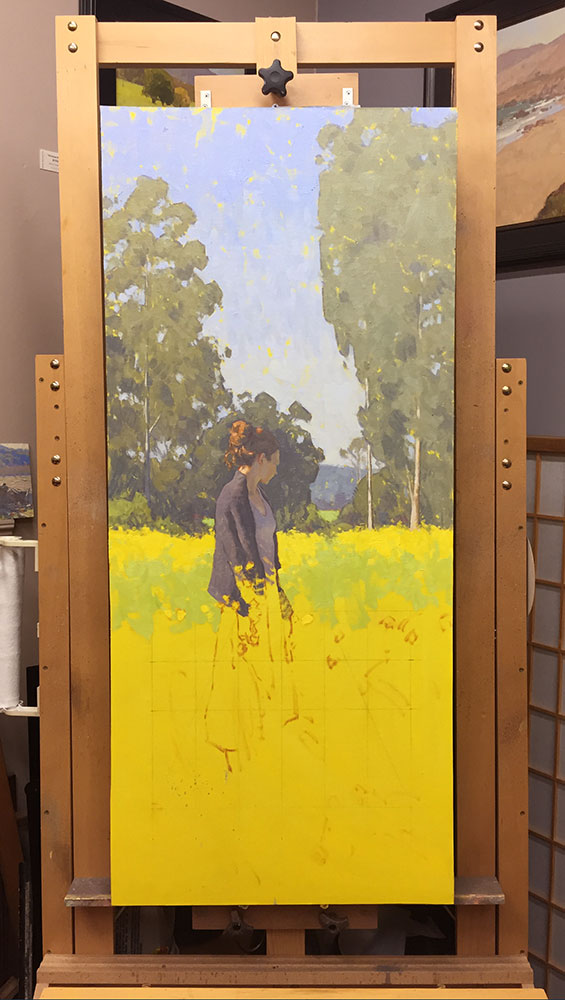
Let me clarify that I’m referring to underpainting as a simple wash of color. Some artists use the term “underpainting” to describe a more developed value study of their scene with all the shapes defined and rendered in one or two colors of paint. This is often done using earth tones or grays in a full-value range of lights, mid tones and darks. (You may hear it defined as a “grisaille.”) That kind of underpainting is then painted over with the proper colors of the scene to finish the painting. I personally haven’t found that to be of much use in my process, but perhaps I’ll talk about it in a future post.
Feel
Feel
A canvas coated with an underpainting accepts paint differently than a blank, white canvas. It feels different. (Try it both ways and see what you think.) You may find that the feel of an underpainted surface is helpful in your process.
Underpainting for Color Harmony: for this painting (pictured while in progress) I chose an intense yellow underpainting to create harmony between the yellow mustard flowers in the lower portion of the painting with the trees and sky in the upper portion. I made sure that the value of the underpainting was close to the value of what I planned to paint for the sky and the mustard flowers.
A word of caution: if you plan on painting wet-into-wet, a freshly-applied underpainting can easily mix with colors painted on top of it. Until you’re able to control that aspect it can be wise to let the underpainting dry before continuing the painting. However, you may find some advantages in allowing the underpainting color to mix with your other colors.
Value
An underpainting can quickly change the value of your canvas from bright white to something closer to the overall value of the scene you’re painting. This can make it easier to judge value and color relationships.
Once applied, you can proceed to cover up all of the underpainting as you complete the painting. Or you can allow the underpainting color to peek through in strategic places across the canvas to achieve desired effects.
If you choose to let it peek through, be mindful that the value you choose for your underpainting color will affect the look of the finished painting. If it’s a very light value under a dark painting (or vice versa), the underpainting will be prominently visible and perhaps distracting. I find that keeping the value of the underpainting color close to the overall value of the scene allows it to affect the colors of the painting without becoming distracting in value.
You may of course choose to underpaint different areas of your canvas with different colors. For example, you might choose a color that’s light in value for the sky area of your scene and a darker color for the rest of the scene.
Color
Underpainting to Enhance a Color Effect: for this painting (pictured while in progress) I chose an intense pink underpainting to create color excitement and to enhance the feel of the bright sunset. I made sure that the value of the pink underpainting was close to the value I planned to use for the mass of trees so that the underpainting wouldn't jump out as a value change, but instead be an exciting color change.
Underpainting to Enhance a Color Effect: (Click image for full description)
An underpainting can help create harmony. For example, you might choose to underpaint with yellow ochre if the scene you’re painting includes a large golden wheat field. The bits of yellow ochre that peek through between the other colors can help create harmony.
An underpainting can help create a more colorful painting. For example, on a gray overcast day, using an intense yellow or orange underpainting can add some color excitement to what might otherwise be a boring gray painting. (As long as you make sure some of the underpainting remains visible.)
An underpainting can enhance a color effect. You might choose an underpainting color that’s opposite of the overall color harmony in the scene you’re painting. (Opposite on the color wheel.) For example, a red or pink underpainting for a predominately green scene.
How to Apply
An underpainting can enhance a color effect. You might choose an underpainting color that’s opposite of the overall color harmony in the scene you’re painting. (Opposite on the color wheel.) For example, a red or pink underpainting for a predominately green scene.
How to Apply
The process of applying a wash of color as an underpainting is pretty simple. First, choose your color and mix up a generous portion of it on your palette. Then thin it into a somewhat runny consistency with mineral spirits and apply it to your canvas with a large bristle brush. Finally, wipe an absorbent paper towel across the surface of the canvas to unify the color and to remove the excess wetness. The color that remains is your underpainting color. You should then be able to paint right on top of it. (Or you can wait until it dries before continuing the painting.)
